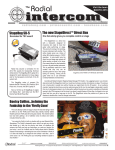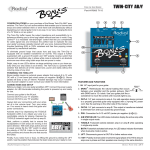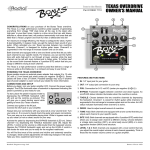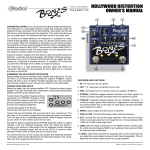Download Radial Engineering STAGEDIRECT User guide
Transcript
www.radialeng.com ® True to the Music STAGEDIRECT ™ Active Direct Box with Mute User Guide ® True to the Music Radial Engineering Ltd. 1588 Kebet Way, Port Coquitlam BC V3C 5M5 tel: 604-942-1001 • fax: 604-942-1010 [email protected] • www.radialeng.com Radial StageDirect ® ™ Active Direct Box with Mute Table of Contents Page What is a direct box anyway ............................................1 Features ...........................................................................2 Getting started with power and connections ....................3 Using the PAD and tuner output ......................................4 Using the mute footswitch ................................................5 Using the remote mute ....................................................5 Various remote footswitch setups ....................................6 Remote control with the Radial SW2 footswitch ..............7 Using the high-pass filter .................................................8 Using the polarity and phase reverse ..............................9 Eliminating hum and buzz .............................................. 10 Specifications ................................................................. 11 Radial Limited Warranty...................................Back Cover INTRODUCTION Congratulations on your purchase of the Radial StageDirect! The StageDirect combines a high quality Radial active direct box with a guitarstyle mute footswitch and separate tuner out that lets you mute the signal with a single foot stomp. This enables you to switch instruments or tune up without disrupting the audience or introducing the popping noise that typically occurs while ‘hot-swapping’ your cable from one instrument to the next. Designed to be super easy to use, the StageDirect will get you up and running in no time. That said, as with any new product that you get your hands (or feet) on, we recommend that you take a little time to read through the manual in order to familiarize yourself with the StageDirect so you can get the most out of it. If you have any questions that are not covered in this manual, please consult the FAQ section on the web site as this is where we post the latest updates and questions from other users. If you still can’t find what you are looking for, feel free to send us a note at [email protected] and we will do our very best to reply in short order. Now let’s make some foot-stomping music! True to the Music ® WHAT IS A DIRECT BOX ANYWAY? A direct box (aka a DI box) is a device that lets you interface hi-impedance instruments (hi-Z) like electric guitar, bass or keyboard with professional low impedance (low-Z) PA and recording systems. Direct boxes, like the StageDirect, first split the unbalanced hi-Z signal in order to output it to your amp and tuner, then converts it to a low-Z balanced output that can connect to a professional audio system. Direct boxes like the StageDirect ensure the signal is delivered to the PA as faithfully as possible. The hi-Z instrument cables you use to connect your instrument, amp and tuner employ unbalanced ¼” connectors at both ends and are particularly sensitive to noise caused by magnetic fields and tone-killing capacitance when extended beyond 6 meters (20’). To keep these instrument cables as short as possible, the StageDirect is usually placed at your feet or near your amp and the lo-Z balanced XLR output is used to extend your instrument signal to the PA system to 100 meters or more (300’) by lowering the impedance and balancing the signal. YOUR INSTRUMENT YOUR AMP & TUNER PA SYSTEM HI-IMPEDANCE OUTPUT LO-IMPEDANCE OUTPUT HI-IMPEDANCE INPUT HI-IMPEDANCE OUTPUT The instrument input, tuner output and amp output are designed for hi-impedance ¼” guitar cables with a max length of 6 meters. The low-impedance output to the PA uses a balanced XLR cable with a max length of 100 meters (300’). Radial Engineering Ltd. 1 StageDirect™ Active Direct Box True to the Music ® FEATURE SET 1 2 3 4 5 10 6 11 9 12 7 8 1. POWER SUPPLY (15VDC-400mA): Use to connect the included power adapter. 2. LIFT: Disconnects pin-1 on the XLR output to help eliminate hum and buzz caused by ground loops. 3. BAL OUT: Lo-Z balanced output used to feed the PA system. Follows standard AES format with pin-1 ground, pin-2 hot (+) and pin-3 cold (-). 4. 180°: Reverses the electrical polarity at the XLR output to help eliminate acoustic hot-spots on stage that can cause feedback. 5. REMOTE: Connection for a momentary (non-latching) footswitch that enables remote control of the mute function. 6. TUNER: Hi-Z ¼” output allows you to connect an electronic tuner. It is always active and can be used for silent tuning with the mute footswitch. 7. INPUT: Hi-Z ¼” input used to connect your instrument. 8. FOOTSWITCH: Mutes the stage amp output and the balanced XLR output, leaving the tuner output active for silent adjustments on stage. The LED’s toggle from green (on) or red (mute). 9. AMP: Hi-Z ¼” output is used to feed the on-stage guitar or bass amplifier and is transformer isolated to eliminate noise caused by ground loops. 10. PHASE: Reverses the electrical polarity 180° at the ¼” AMP output to help eliminate acoustic hot-spots on stage that can cause feedback. 11. PAD: Reduces the input sensitivity by -10dB to prevent overload from high output devices like keyboards and active pickups. 12. FILTER: 3 position high-pass filter used to eliminate excessive bass to help reduce feedback and low frequency resonance. Radial Engineering Ltd. 2 StageDirect™ Active Direct Box True to the Music ® GETTING STARTED Before making any connections, always ensure your audio system is either turned down or turned off in order to protect more sensitive components from damage due to turn-on or plug-in transients. PHANTOM OR AC ADAPTER The Radial StageDirect is unique in that it may be powered using either 48V phantom from the PA system or by using the included 15VDC power supply. Most musicians will likely use phantom power as it is convenient. The 15VDC power supply gives you the option should phantom power not be available. A cable clamp is provided to lock down the power cable. Use a screw driver to loosen and loop the cable through before retightening the clamp. There is no power switch on the StageDirect. As soon as you plug in the power supply or turn on phantom power, it will come to life. One of the top panel LED indicators will illuminate to let you know Power 48V power is being received. Adapter Phantom MAKING CONNECTIONS Plug the hi-impedance ¼” instrument cable from your guitar or bass into the StageDirect INPUT. Connect a standard low-impedance XLR cable from the BALANCED OUT jack on the StageDirect to the PA system. If you are using a stage amp, connect a second hi-impedance ¼” instrument cable from the AMP output jack to your amplifier. The AMP output is transformer isolated to help eliminate noise caused by ground loops. For best results keep hi-Z instrument cable under 6 meters(20’). Connections for instrument, stage amp and PA system. Radial Engineering Ltd. 3 StageDirect™ Active Direct Box True to the Music ® USING AND TESTING Bring up the level on the PA system. It is good practice to always test at a low volume to ensure proper connections have been made and all devices in the signal chain are working. This way, should a device not be turned on or a connector not fully pushed in, it will not create a loud transient ‘pop’ in the PA which in turn could blow a tweeter or annoy your audience. Check the status of the two footswitch LED indicators. If the indicator labeled ON is not illuminated, depress the footswitch to un-mute and turn on the StageDirect’s outputs. If you are using a stage amp, slowly turn up the volume and test it as well. USING THE -10DB PAD If you hear distortion, check to make sure the trim control on the PA is set correctly. If the problem persists your instrument signal is likely overloading the StageDirect input. This can happen when connecting high-output electronic instruments like keyboards and bass guitars with active pickups. To eliminate the distortion, engage the StageDirect’s PAD using the switch on the top panel. When set to the -10dB position, this switch reduces the sensitivity of the instrument input which will eliminate overload distortion. USING THE TUNER OUTPUT The StageDirect is equipped with a separate output for an electronic tuner. The tuner output is not affected by the MUTE footswitch and is always on to let you quickly adjust your tuning on the fly or in silence when the MUTE footswitch is engaged. The connection is made using a standard hi-Z ¼” instrument cable. For best results, use the shortest possible cable to connect your tuner. Connecting a tuner. Radial Engineering Ltd. 4 StageDirect™ Active Direct Box True to the Music ® USING THE MUTE FOOTSWITCH The top mounted mute footswitch adds another dimension by enabling you to turn off the signal going to your stage amp and the PA system by simply depressing the footswitch. Once muted, the tuner output remains active to let you tune in silence without bothering the audience. The mute footswitch also lets you Outputs Outputs Muted Active noiselessly disconnect your guitar or bass to exchange instruments on stage. This is particularly beneficial as it eliminates the need to set your amp on standby or have the audio engineer turn down your channel on the PA system each time you want to change your guitar. When the outputs are muted, the red LED adjacent to the footswitch will illuminate. When the outputs are active, the green LED adjacent to the footswitch illuminates. USING THE REMOTE MUTE The StageDirect may also be remotely muted using a ¼” tip-sleeve momentary (non-latching) footswitch. These are available from your local music store and are often used as a sustain pedal for an electronic piano. Typical momentary footswitch. Simply plug the momentary pedal’s ¼” connector into the REMOTE input jack to test. The local footswitch on the StageDirect will continue to function allowing you to control the mute function from either footswitch. Remote footswitch connection. Radial Engineering Ltd. 5 StageDirect™ Active Direct Box True to the Music ® VARIOUS REMOTE MUTE SETUPS The remote footswitch can be used in a few different ways depending on your setup. For instance, you could locate the StageDirect off-stage with your amplifier and use the remote footswitch on your pedalboard. REMOTE FS AMP PEDALBOARD You could also have your guitar tech do the switching by locating the remote footswitch off-stage. This lets him swap guitars in between songs without missing a beat. REMOTE FS AMP Players who use a wireless system with their instruments can locate the remote mute on the front line and keep the StageDirect with their amplifier setup in a tidy package on the backline. REMOTE FS AMP WIRELESS WIRELESS You could also use a MIDI controller equipped with momentary contact closure output to remotely mute the StageDirect as part of a larger MIDI switching setup. The StageDirect’s remote mute function opens doors that were previously closed! MIDI SWITCHER AMP Radial Engineering Ltd. MIDI PEDAL 6 StageDirect™ Active Direct Box True to the Music ® REMOTE SWITCHING WITH THE RADIAL SW2 FOOTSWITCH For even more control over your system you can employ the Radial SW2 footswitch. This programmable controller features two footswitches that can operate the mute function on the StageDirect and one other device that has a footswitch input. You can employ the second footswitch to change channels on your stage amp or turn an effect unit on and off. You can even link the SW2 footswitches together and trigger the second device at the same time the StageDirect mutes or unmutes. The SW2 is powered by a standard 9 volt adaptor (not included). The SW2 supports both ‘latching’ and ‘pulse’ footswitch signals, thus enabling the SW2 to control older amplifers with contact closure type switching and newer electronics and amps with pulse sensing switching. AMP Radial SW2 The SW2 can connect to the StageDirect to control the mute function and to an amp’s channel switching footswitch. RACKMOUNT EFFECT Radial SW2 The SW2 can connect to the StageDirect to control the mute function and to an effect such as a rackmount digital reverb. Radial Engineering Ltd. 7 StageDirect™ Active Direct Box True to the Music ® MANAGING FEEDBACK The StageDirect has two built-in features that are designed to help reduce resonant feedback when using an acoustic instrument on stage. These include a high-pass (low cut) filter and 180° polarity reverse switches. USING THE HIGH-PASS FILTER A powerful feedback fighting feature is the builtin high-pass filter. This 3-position switch lets you remove low frequencies from the signal path to eliminate resonance and ‘size the instrument’. In other words, smaller instruments like the mandolin, do not produce very low frequencies so removing unused bass can prevent resonance and achieve more gain before the onset of feedback. Removing unneeded low frequencies from the instrument signals also helps tremendously by cleaning up the mix. This rids the PA from warbling effects as various frequencies modulate together which can cause the mix to sound muddy and instruments indistinct. Simply set the high-pass filter to the setting that sounds best to you. Filter setting-1 is FLAT or bypass. Use this setting when you don’t want any low frequencies removed from your signal. Setting-1 works well for acoustic/electric bass and full range devices like keyboards. Setting 1: Flat or bypass Filter setting-2 gently rolls off low frequencies below 60Hz. Use this setting when you want to remove the very low end of your signal. Filter setting-2 works well with acoustic guitar and other midrange instruments allowing them to sound natural while achieving more gain before feedback. Setting 2: -3dB at 60Hz Filter setting-3 also rolls off low frequency at a gentle rate but the effect starts at the higher 200Hz mid-bass frequency range. Use setting-3 with an instrument that does not produce a lot of low frequencies like violin, accordion and mandolin to achieve a cleaner, tighter sound with improved gain before feedback. Radial Engineering Ltd. Setting 3: -3dB at 200Hz 8 StageDirect™ Active Direct Box True to the Music ® Using the phase and 180° polarity reverse Resonant feedback generally occurs when a powerful low-frequency wave on stage causes the top of the instrument to vibrate. This low frequency wave may be produced by the stage monitors, PA system, stage amp or a combination as they interact together in the acoustic space. When two waves from different speakers collide in phase they can increase in amplitude causing a resonant peak or ‘hot spot’ on stage. If this hot spot happens to be where you are standing on stage your instrument will feedback. A B A B + = In-phase frequencies from the floor monitor (A) and the stage amp (B) combine and create a feedback hotspot. By changing the polarity (or relative phase) of the direct box output, one of the two waves can be inverted which will cause phase cancellation and instead of a hot spot, it creates a ‘null’. You can often use this technique to electronically move the resonant frequency out of the way and achieve more gain before the onset of feedback. A B + = Inverting the polarity of the XLR output reverses the phase of the floor monitor (A) and creates a null when combined with the stage amp (B). The StageDirect has two 180° polarity reverse switches. One is for the lo-Z XLR output and reverses pin-2 and pin-3. The other is on the hi-Z AMP output and reverses the phase of the signal going to your amp. Try changing the polarity going to the PA first, then your stage amp to find the combination that works best. 180°: inverts the polarity of the low-Z XLR output Radial Engineering Ltd. PHASE: inverts the polarity of the hi-Z ¼” AMP output 9 StageDirect™ Active Direct Box True to the Music ® ELIMINATING HUM AND BUZZ Solving noise problems on stage is a never ending battle! The StageDirect has been designed to minimize noise by incorporating a dual purpose ground lift switch that isolates the audio signal ground in a specific way, depending on which power source is being used. Lifting the signal ground usually helps to reduce the hum and buzz caused by ground loops. When using the 15VDC supply, lifting the ground results in a true 100% ground lift by disconnecting pin-1 on the XLR output. When using phantom power, lifting the pin-1 ground also disconnects the 48V DC supply. As such, when powered by 48V phantom, the StageDirect employs a quasi ground lift scheme that provides a virtual ground lift, while still enabling phantom power to pass. If noise is encountered coming from the XLR output and heard through the PA system, simply depress the recessed ground lift switch using a small screwdriver. Recessed ground lift switch for the XLR output located on the rear panel. To further reduce the opportunity for noise to pollute the audio system, the hi-Z ¼” stage amp output is transformer isolated. This helps eliminate hum and buzz caused by ground loops. The transformer isolates the output going to your stage amp. Radial Engineering Ltd. 10 StageDirect™ Active Direct Box True to the Music ® SPECIFICATIONS* Audio circuit type: .................Active Buffer with class-A FET front end Frequency response: ................................................... 20Hz ~ 20kHz Total harmonic distortion: ........................................................<0.01% Dynamic range: ........................................................................ 100dB Instrument input impedance: ............................................ 250k Ohms Maximum input: ...................................................................... +13dBu XLR output impedance: ...................................................... 250 Ohms Equivalent input noise: ............................................................ -87dBu Intermodulation distortion: ........................................................0.012% DI out phase deviation: ....................................................... 8° at 50Hz XLR configuration: ............................ Pin 1 ground, Pin 2 (+), Pin 3 (-) Remote switch:........................ Momentary (pulse) ¼” contact closure Power: ............... 48V phantom power or 15V external power adapter Construction: ..........................14 gauge steel chassis and outer shell Finish:............................................................................Baked enamel Warranty: ...................................................Radial 3-year, transferable *Specifications are subject to change without notice. BLOCK DIAGRAM CLASS A FET BUFFER PAD MUTE FOOT SWITCH LOW CUT FILTER INPUT -10dB FLAT 0dB REMOTE FOOTSWITCH TUNER OUT UNITY GAIN BUFFER PHANTOM POWER IN PHASE INVERTING BUFFER BAL. OUT BAL. OUT PHASE 180° (INVERTED) 0° (NORMAL) LAT GROUND LIFT 180° (INVERTED) 0° (NORMAL) TRANSFORMER ISOLATION Radial Engineering Ltd. 11 AMP OUT PHASE UNBAL. ISOLATED AMP OUTPUT StageDirect™ Active Direct Box THREE YEAR TRANSFERABLE LIMITED WARRANTY RADIAL ENGINEERING LTD. (“Radial”) warrants this product to be free from defects in material and workmanship and will remedy any such defects free of charge according to the terms of this warranty. Radial will repair or replace (at its option) any defective component(s) of this product (excluding finish and wear and tear on components under normal use) for a period of three (3) years from the original date of purchase. In the event that a particular product is no longer available, Radial reserves the right to replace the product with a similar product of equal or greater value. In the unlikely event that a defect is uncovered, please call 604-942-1001 or email [email protected] to obtain an RA number (Return Authorization number) before the 3 year warranty period expires. The product must be returned prepaid in the original shipping container (or equivalent) to Radial or to an authorized Radial repair center and you must assume the risk of loss or damage. A copy of the original invoice showing date of purchase and the dealer name must accompany any request for work to be performed under this limited and transferable warranty. This warranty shall not apply if the product has been damaged due to abuse, misuse, misapplication, accident or as a result of service or modification by any other than an authorized Radial repair center. THERE ARE NO EXPRESSED WARRANTIES OTHER THAN THOSE ON THE FACE HEREOF AND DESCRIBED ABOVE. NO WARRANTIES WHETHER EXPRESSED OR IMPLIED, INCLUDING BUT NOT LIMITED TO, ANY IMPLIED WARRANTIES OF MERCHANTABILITY OR FITNESS FOR A PARTICULAR PURPOSE SHALL EXTEND BEYOND THE RESPECTIVE WARRANTY PERIOD DESCRIBED ABOVE OF THREE YEARS. RADIAL SHALL NOT BE RESPONSIBLE OR LIABLE FOR ANY SPECIAL, INCIDENTAL OR CONSEQUENTIAL DAMAGES OR LOSS ARISING FROM THE USE OF THIS PRODUCT. THIS WARRANTY GIVES YOU SPECIFIC LEGAL RIGHTS, AND YOU MAY ALSO HAVE OTHER RIGHTS, WHICH MAY VARY DEPENDING ON WHERE YOU LIVE AND WHERE THE PRODUCT WAS PURCHASED. ® www.radialeng.com Radial Engineering Ltd. 1588 Kebet Way, Port Coquitlam BC V3C 5M5 tel: 604-942-1001 • fax: 604-942-1010 [email protected] • www.radialeng.com Radial® StageDirect™ User Guide - Part# R870 1234 00 Specifications and appearance are subject to change without notice.























